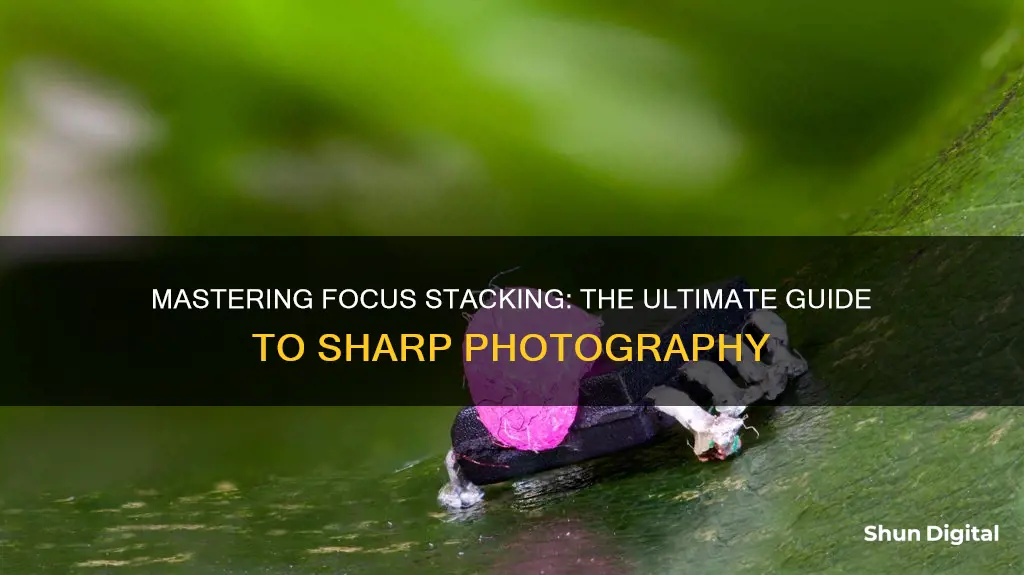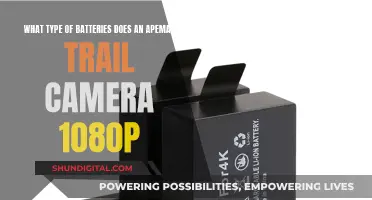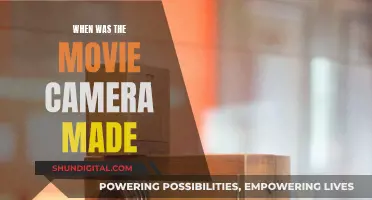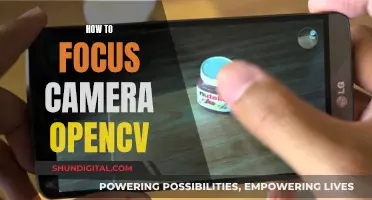
Focus stacking is a photography technique that allows photographers to create a single image where objects at various focal planes are all in focus. This technique is often used in landscape, product, and macro photography, where different elements need to be in focus. It involves capturing multiple shots of the same composition with different focal points, which are then merged in post-production to create a single image with a deeper depth of field.
| Characteristics | Values |
|---|---|
| Definition | A technique that allows photographers to create a single image where objects on various focal planes are all in focus. |
| Other Names | Photo stacking, focus layering |
| Use Cases | Landscapes, products, macro photography |
| Equipment | Camera that can shoot in manual mode, Photoshop or other focus stacking software |
| Advantage | Can create insanely sharp images that are impossible to achieve otherwise |
| Disadvantage | Can be a tedious technique for one image |
| Image Resolution | Higher resolution cameras capture finer details for better final images |
| Autofocus System | Must be precise and reliable for taking multiple shots with varying focus points |
| Focus Stacking/Bracketing Modes | Simplify the process significantly |
| Battery Life and Ergonomics | Essential for extended shooting sessions, ensuring comfort and productivity |
What You'll Learn

Focus Stacking: The technique
Focus stacking is a technique in photography that allows photographers to create a single image where objects at varying distances are all in focus. It is also called photo stacking, focus layering, focal plane merging, z-stacking, or focus blending. Focus stacking is often used in landscape photography, product photography, and macro photography, where various elements at different focal planes need to be in focus.
The technique involves capturing multiple images of the same composition, each with a different focal point. These images are then combined in post-processing using software like Photoshop or other focus stacking software to create a single image with a greater depth of field than any of the individual images.
- Compose your shot: Start by framing the shot and composing the different elements within the frame. It is important to be sure about your composition as focus stacking involves merging multiple images. You may need to crop the image during post-processing, so shoot a bit wider than usual to avoid cropping out important details.
- Adjust your settings: Set your camera to manual mode to have full control over the exposure triangle. Keep the ISO low to avoid image noise, and use a wider aperture to capture more detail. Ensure your shutter speed is fast enough to keep your images sharp.
- Focus on the first area: Set your camera to single-point focus mode and focus on the area of the photo that is closest to the lens. Take the photo and check that your exposure and focal point are correct.
- Take multiple shots with varying focus points: Change the focal point of the camera to the next section of the image and take another shot. Repeat this process, slowly moving the focal point backward until you have captured sharp versions of every part of the scene.
- Blend the images in post-processing: Use software like Photoshop or other focus stacking software to blend the images into a single, focus-stacked image. This process is often automated, making it easier to create the final stacked image.
Focus stacking is particularly useful when working with very deep landscape scenes, ultra-close macro subjects, or deep building interiors, where a single image may not have a deep enough depth of field to keep the entire scene sharp.
How License Plate Readers Are Catching Speedsters
You may want to see also

Focus Stacking: Equipment needed
Focus stacking is a technique that allows photographers to create a single image where objects at various focal planes are all in focus. The process involves capturing multiple images of the same composition with different focal points, which are then merged using photo editing software. Here's a list of the essential equipment you'll need to get started with focus stacking:
- Camera: You'll need a camera that can shoot in manual mode, allowing you to adjust the focus for each shot. Both DSLR and mirrorless cameras are suitable, but ensure your camera has a manual focus option.
- Tripod: A tripod or any fixed stabiliser is crucial for focus stacking. Since you'll be merging multiple photos, it's essential that each image has the exact same composition. A tripod helps to keep your camera steady and in the same position for each shot.
- Lens: The choice of lens depends on the type of photography you're doing. For macro photography, consider a macro lens with a focal length between 90mm and 150mm. For landscapes or product photography, a wider lens may be more suitable.
- Software: You'll need photo editing software to merge your images into a single, focused image. Adobe Photoshop is a popular choice, but other options include Helicon Focus, Zerene Stacker, and CombineZP. These specialised focus stacking softwares often have more advanced features for this technique.
- Lighting: While not mandatory, a good lighting setup can improve your results. Continuous lighting or flash can be used, but diffused lighting is generally recommended to reduce harsh shadows and provide even illumination.
- Focus Stacking Rails: If you're interested in investing in more advanced equipment, focus stacking rails can help automate the process of capturing images at different focus points. These rails move the camera or the subject to vary the plane of focus.
Monthly Fees for Cellular Cameras: What's the Deal?
You may want to see also

Focus Stacking: How to do it
Focus stacking is a technique in photography that allows you to create a single image where objects at varying distances from the camera are all in focus. It is particularly useful when you want to capture images with multiple elements in focus, such as landscapes, products, or macro photography.
- Compose your shot: Start by framing the shot you want and arranging the different elements within the frame. It is important to be sure about your composition as focus stacking involves merging multiple images. You will also need to set your camera to manual mode so that you can vary your focal points for different shots.
- Adjust your settings: Ensure consistency in exposure from shot to shot. Keep your ISO low to avoid image noise. Using a wider aperture will help capture more detail but will also require you to take more shots. Adjust your shutter speed to ensure your images remain sharp.
- Focus on the first area of the image: Set your camera to single-point focus mode so that you can adjust the specific focal point. Focus on the area of the photo that is closest to the lens, take the photo, and then check that your exposure and focal point are correct.
- Take multiple shots with varying focus points: Change the focal point of the camera to the next section of the image and take another shot. Repeat this process, slowly moving the focal point backward until you have captured photos of every section in focus.
- Blend the images in post-processing: Use software such as Adobe Lightroom and Photoshop to blend the images together. First, upload the files from your shoot into Lightroom and select the photos you wish to focus on. Apply any edits you want to see in the final photo to the first photo in the stack and then synchronize these edits to the rest of the photos. Open the images in Photoshop, ensuring they are selected as layers. Then, auto-align and auto-blend the layers to create a single, focus-stacked image.
Focus stacking can be a tedious process, but it is worth it to achieve incredibly sharp images. With practice, you will be able to master this technique and create unique and versatile photographs.
Camera Battery Explosions: How Common Are They?
You may want to see also

Focus Stacking: Post-processing
The post-processing stage of focus stacking is where the magic happens. It is the process of merging multiple images with different focal points into one final image with a greater depth of field. This can be done using various software programs, such as Adobe Photoshop, Lightroom, Helicon Focus, or Zerene Stacker. Here is a step-by-step guide to focus stacking post-processing:
Step 1: Import Images
The first step is to import all the images that will be used for the focus stack into the chosen software. This can be done by selecting the images and opening them as layers in Photoshop or Lightroom. In Helicon Focus, the files are imported and the user chooses one of three different stacking approaches.
Step 2: Align Layers
Once the images are imported, it is important to align them to compensate for any small movements or changes in composition between the shots. In Photoshop, this can be done by selecting all the layers and going to "Edit > Auto-Align Layers".
Step 3: Blend Layers
After alignment, the next step is to blend the layers together. In Photoshop, this is done by selecting "Edit > Auto-Blend Layers" and choosing the "Stacking Images" option. The Photoshop algorithm will then analyse each pixel and select the sharpest ones from each image by revealing or concealing them through layer masks. In Helicon Focus, the rendering process will automatically blend the images.
Step 4: Manual Adjustments
Depending on the complexity of the images, some manual adjustments may be needed to ensure a seamless blend. In Photoshop, this can involve creating a "Stamp Visible Layer" and using a black brush to paint over any soft spots, revealing the sharper layer beneath. In Helicon Focus, it is recommended to zoom in and check that everything is in focus, and further adjustments can be made in Photoshop or other software.
Step 5: Final Export
Once the focus stack is complete, the final image can be exported and further edited as desired. This may involve additional adjustments to colours, exposure, or other enhancements to create the desired final product.
Focus stacking is a powerful technique that allows photographers to achieve sharpness from the foreground to the background of an image. While it requires some practice and patience, the results can be well worth the effort, especially in landscape and macro photography.
Fight Traffic Camera Tickets: Florida Drivers' Guide
You may want to see also

Focus Stacking: When to use it
Focus stacking is a technique used in photography to create a single image where objects at varying distances from the camera are all in focus. It is often used in landscape, product, and macro photography, where different elements need to be in focus.
Focus stacking is ideal when you want to capture an image with multiple elements in focus, such as flowers in the foreground and a sunset in the background. It is also useful when working with very deep landscape scenes, ultra-close macro subjects, or deep building interiors.
The technique is particularly helpful when you cannot achieve a deep enough depth of field to keep the entire shot sharp, from the nearest foreground element to the most distant background element.
For example, if you are using a wide aperture like f/22, you will get a deeper depth of field, but it will reduce the amount of light entering the camera and decrease the clarity of the image.
Focus stacking can be done with just a standard camera or even a smartphone camera. However, for best results, it is recommended to use a tripod, an interchangeable-lens camera, a lens with manual focusing capabilities, and focus-stacking software like Photoshop, Helicon Focus, or Zerene Stacker.
When deciding whether to use focus stacking, consider the distance to your subject. As you zoom in, move closer, or use a wider lens aperture, the amount of the scene in focus will decrease. Conversely, as you widen your lens, move away, or narrow your lens aperture, the amount of the scene in focus will increase.
In most cases, you can manage your depth of field requirements without focus stacking. For instance, when shooting a sweeping landscape, you can use a wide-angle lens and a narrow aperture to capture the entire scene in focus.
However, in certain situations, you may not be able to achieve a deep enough depth of field, and that's when focus stacking becomes a valuable tool.
Fighting a NY Speeding Ticket: What You Need to Know
You may want to see also
Frequently asked questions
Focus stacking is a technique in photography that allows photographers to create a single image where objects on various focal planes are all in focus.
Focus stacking is done by bracketing a number of images of the same subject with slightly different parts in focus. These images are then blended together, or 'stacked', in post-production to produce a single image that has a greater depth of field.
You need a camera that can shoot in manual mode and Photoshop or other focus stacking software.
Focus stacking is particularly useful when you want to capture an image with multiple elements at varying distances and want all of them to be completely in focus.







